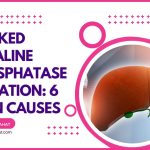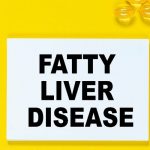Marked Alkaline Phosphatase Elevation (levels over 600): 6 Main Causes
Our content is not intended nor recommended as a substitute for medical advice by your doctor. Use for informational purposes only.
Hello Everyone! Dr Farahat Here.
Many physiological and disease conditions cause elevations in alkaline phosphatase.
However, marked elevations in alkaline phosphatase (more than four times the upper limit of normal or above 600 U/L) is specific for a certain disease.
Today, You will learn about the causes of marked elevations (more than 600) of alkaline phosphatase, the symptoms, and the diagnosis of each cause.
The table below illustrates the causes of elevated alkaline phosphatase (reference).
The main causes of marked elevations in alkaline phosphatase include biliary obstruction, liver diseases such as primary biliary cholangitis, transient hyperphosphatasemia in infancy and early childhood, liver transplant rejection, and others.
Causes of Marked ALP elevations (>600 U/L). | Causes of mild to moderate elevations (<600 U/L) |
| 1. Obstruction of the bile ducts by a gallstone. | 1. Bone growth (children & adolescents). |
| 2. Other causes of bile duct obstructions (cancers, strictures, infections). | 2. Pregnancy (third trimester). |
| 3. Liver disease leading to marked bile stasis inside the liver (intrahepatic cholestasis) – Toxin or Drug-induced cholestasis. – Primary biliary cholangitis. – Primary sclerosing cholangitis. – Metastatic cancer in the liver. – Infiltration of the liver with T.B., Sarcoidosis, etc. – Others. | 3. liver diseases causing mild cholestasis: – Hepatitis: alcoholic, viral, or chronic. – Liver Cirrhosis. – Early stages of the liver infiltrative disease. – decreased blood supply to the liver (hypoperfusion). |
| 4. Transient hyperphosphatemia of infancy and childhood. | 4. Bone diseases. |
| 5. Liver transplant rejection. | 5. People with blood groups O & B. |
| 6. Total Parentral Nutrition (TPN). | 6. Some types of cancer. |
| 7. Others, such as thyroid diseases, diabetes, etc. |
The first column lists the causes of marked ALP elevations; the second column lists the causes of mild to moderate (less than 600) elevations.
What are the normal reference ranges?
The normal ranges of alkaline phosphatase vary significantly according to age. Being highest during childhood and early adolescence (periods of bone growth).
The normal range of alkaline phosphatase in adults above 20 is between 44 and 121 U/L (reference).
In young infants (during the first six months of age), the upper limit of alkaline phosphatase may reach more than 500. However, alkaline phosphatase of more than 600 U/L is not considered a normal variant at any age.
The table below illustrates the reference ranges of the alkaline phosphatase according to age and gender.
The data below is according to the famous U.S. laboratory (labcrop®).
Age | Male (IU/L) | Female (IU/L) |
| 0 to 5 d | 47−127 | 47−127 |
| 6 to 10 d | 29−242 | 29−242 |
| 11 to 20 d | 109−357 | 109−357 |
| 21 to 30 d | 94–494 | 94–494 |
| 1 to 2 m | 149−539 | 149−539 |
| 3 to 6 m | 131−452 | 131−452 |
| 7 to 11 m | 117−401 | 117−401 |
| 12 m to 6 y | 158−369 | 158−369 |
| 7 to 12 y | 150−409 | 150−409 |
| 13 y | 156−435 | 78−227 |
| 14 y | 114−375 | 64−161 |
| 15 y | 88−279 | 56−134 |
| 16 y | 74−207 | 51−121 |
| 17 y | 63−161 | 47−113 |
| 18 to 20 y | 51−125 | 42−106 |
| >20 y | 44−121 | 44−121 |
Also, the chart below shows the upper limits of normal alkaline phosphatase levels according to age and gender.
Note the vertical black dotted line; It represents the upper limit of normal alkaline phosphatase in adults above 20.
Causes of alkaline phosphatase over 600?
1. Stone obstructs the bile ducts.
Bile is formed inside your liver and is transported through a network of bile ducts inside the liver (intrahepatic biliary ducts) and outside the liver (extrahepatic biliary ducts).
Your gallbladder acts as a temporary storage site for bile till the time of the next meal.
A considerable percentage of adults develop gallstones in their gallbladder. Eventually, a small gallstone may escape the gallbladder and enter the common bile duct.
A gallstone stuck inside the common bile duct is the most common cause of markedly elevated alkaline phosphatase (above 600 U/L).
Fortunately, the obstruction of the bile duct is an easy-to-diagnose condition with characteristic symptoms and patterns in laboratory and imaging studies.
However, it is also a dangerous medical condition that may lead to life-threatening complications if not treated urgently.
Common complications of biliary obstruction by gallstone include:
- Acute cholangitis: stasis of the bile inside the obstructed biliary duct predisposes its infection with fever and sepsis.
- Gallstone pancreatitis: some gallstones may obstruct the terminal part of the biliary system (the last part of the common bile duct joins the pancreatic duct), obstructing the pancreatic duct and leading to acute pancreatitis.
Symptoms:
- Pain: Acute onset of extreme dull, aching upper right abdominal pain may radiate to the upper central abdomen (epigastric area), the right back, and the right shoulder.
- Duration of the attack: The pain comes in attacks that often last several hours (a single attack may exceed 6 hours).
- Associated symptoms: During the attack, severe nausea, anorexia, and vomiting often occur.
- You may develop jaundice (yellowish skin and eye whites) a few days late.
- Dark (tea-colored) urine.
- Fever may occur (especially with the development of acute cholangitis or pancreatitis).
- In gallstone pancreatitis, the pain may become central, persistent, and radiate to the back (typical pancreatitis pain).
- In severe cases, signs of sepsis may occur in the form of shortness of breath, dizziness, confusion, fast heartbeats, low blood pressure, etc.
Diagnosis and treatment:
The condition is easily suspect based on the characteristic symptoms and signs (biliary pain, jaundice, etc.).
Your doctor often confirms the diagnosis by:
- Laboratory tests:
– Markedly elevated alkaline phosphatase (often above 600 U/L),
– Elevated bilirubin levels (mainly the conjugated type),
– And sometimes, elevated liver enzymes and total leucocyte count (indicating cholangitis),
– Elevated lipase and amylase levels (indicated gallstone pancreatitis in some cases). - Imaging studies:
Often shows evidence of biliary obstruction (dilated common bile duct) and the obstructing stone.
– Abdominal Ultrasound.
– Abdominal CT.
– Abdominal MRI.
– A special type of MRI is used in difficult cases, and it is called MRCP (Magnetic Resonance Cholangiopancreatography).
The treatment of obstructive jaundice is by relieving the obstruction using a specialized endoscopic technique called the ERCP (endoscopic retrograde cholangiopancreatography).
The ERCP relieves the obstruction by removing the obstructing stone with or without stent insertion in the CBD (common bile duct).
After the obstruction is relieved, alkaline phosphatase levels return to their normal levels gradually. A subsequent cholecystectomy operation is often planned to prevent the recurrence of the condition.
2. Other causes of biliary obstruction.
Stones are not the only cause of biliary obstruction.
Several causes may lead to partial or complete obstruction of the biliary system with symptoms and signs of biliary obstruction (explained above) plus the symptoms of the cause (cancer, infection, or strictures).
Causes of biliary obstruction other than gallstones include:
A. Cancer:
A cancer mass inside or near the network of bile ducts can obstruct the bile outflow (whether partially or completely).
Complete obstruction by a cancer mass often leads to marked alkaline phosphatase (over 600 U/L) and bilirubin elevation.
- Cancer head of the pancreas.
- Gallbladder cancer.
- Ampulla of Vatter cancer (obstructing the terminal part of the common bile duct).
- Bile duct cancer.
- Metastatic cancer in the lymph nodes near the bile ducts (commonly, the hilar lymph nodes). The enlarged malignant lymph nodes compress the bile ducts from the outside, obstructing them.
B. Biliary strictures:
A stricture is narrowing a part or several parts of the bile ducts. It causes partial (and sometimes complete) biliary obstruction.
Common causes include:
- Primary sclerosing cholangitis (affecting the extrahepatic ducts):
An immune-mediated disease leading to chronic inflammation of the biliary ducts. The inflammation leads to fibrosis (sclerosis) of the ducts and multiple strictures. - Bile duct injury during operations or ERCP.
- Chronic pancreatitis:
Chronic inflammation of the pancreas leads to scarring and strictures of the terminal part of the common bile duct. - Bile duct strictures following liver transplantation.
C. Biliary system infections:
Infections of the biliary ducts may lead to partial or complete obstruction of the bile ducts either by fibrosis or by the organism itself.
Significant obstruction often leads to elevated bilirubin and marked alkaline phosphatase elevations (more than 600 U/L).
Examples:
- Ascaris lumbricoides helminthic infection of the bile duct (the parasite is large enough to obstruct the bile ducts).
- Liver flukes.
- AIDS cholangiopathy.
3. Liver diseases (leads to bile stasis inside the liver).
As you learned before, the bile system has two sets of ducts:
- The Extrahepatic ducts: the bile ducts outside the liver tissue (such as the hepatic ducts and the common bile duct).
- The intra-hepatic ducts: the network of small bile ducts inside the live tissues.
Obstruction or destruction of the latter type (the intrahepatic ducts) may also cause marked elevations of alkaline phosphatase.
Examples of the disease that cause intrahepatic bile stasis (intrahepatic cholestasis):
- Drug-induced cholestasis such as anabolic steroids and phenytoin. See the complete list here.
- Some toxins such as pesticides.
- Primary biliary cholangitis (chronic immune-mediated inflammation of the liver and biliary tract).
- Primary sclerosing cholangitis affects the intrahepatic ducts.
- Intrahepatic cholestasis of pregnancy (ICP): pregnant women in the third trimester may have elevated alkaline phosphatase up to twice the upper limit of normal (physiological). Elevations more than twice the upper limit of normal alkaline phosphatase (especially if over 600 U/L) and severe itching should raise the suspicion of ICP. Learn More.
- Benign post-operative cholestasis:
It often occurs after major operations (especially cardiac and intra-abdominal operations). - Diseases infiltrating and destructing the liver tissues and the intrahepatic bile ducts:
– Lymphomas.
– Amyloidosis.
– Sarcoidosis.
– T.B. (tuberculosis).
– Liver Abscess. - Cancers spread to the liver (liver Mets).
- Alcoholic hepatitis (severe attacks).
- Sickle cell disease:
Abnormal blood cells become destructed (hemolysis) and may obstruct the small vessels supplying the liver (hepatic crisis). - Others such as IgG4 cholangiopathy, COVID-19, and ischemic cholangiopathy.
4. Transient hyperphosphatemia of infancy and early childhood.
About 2-3% of infants and children younger than five may have transient serum alkaline phosphatase elevations (often above 1000).
The elevations in alkaline phosphatase are not associated with any symptoms or signs of liver or biliary affection.
The condition is not dangerous, and the elevated levels of ALP often return to normal values within weeks or a few months (reference).
So, alkaline phosphatase levels over 600 U/L in infants or toddlers without other symptoms or laboratory arrangements shouldn’t scare you.
However, your pediatrician or hepatologist should make sure that there are no other causes of such elevation.
5. Total parenteral nutrition (TPN).
Patients in the ICU with serious illnesses (such as major intra-abdominal operations, severe acute pancreatitis, or prolonged coma) often receive total parenteral nutrition (TPN).
TPN may induce intrahepatic cholestasis and cause alkaline phosphatase levels over 600 U/L (reference).
However, other common causes, such as biliary obstruction and infiltrative liver disease, should be excluded first.
6. Liver transplantation rejection reaction.
In patients with transplanted liver, a sudden & marked rise in alkaline phosphatase (over 600 U/L) may indicate a rejection reaction.
A rejection reaction is caused by your body’s immune system fighting and destroying the transplanted liver.
7. Other causes (often cause elevations in ALP LESS than 600 U/L).
The below causes typically don’t cause marked alkaline phosphatase elevations. The levels rarely exceed 600 U/L.
However, in rare cases, they may reach levels above 600.
A. Liver diseases.
- Alcoholic hepatitis.
- Acute hepatitis (such as acute hepatitis A).
- Other causes of viral hepatitis (such as Hepatitis B and C).
- Other causes of chronic hepatitis (such as NASH and autoimmune hepatitis).
- Liver cirrhosis.
- Early stages of infiltrative liver diseases.
- Hepatic ischemia (cutting off its blood supply) as with septic shock, bleeding, heart failure, portal vein thrombosis, etc.
B.Bone diseases.
- Bone fractures (during healing).
- Osteomalacia.
- Bone cancers (primary osteosarcoma or bone metastasis).
- Paget’s disease of bone.
- Hyperparathyroidism.
- Hyperthyroidism (increases bone turnover).
C. Pregnancy.
Alkaline phosphatase levels increase significantly during the last three months of pregnancy. Typically, the rise doesn’t exceed twice the upper limit of normal (about 242 U/L) (reference).
D. Bone growth (children and young adolescents).
Alkaline phosphatase is present in two main sites: the liver and bones.
During bone growth (childhood and early adolescence), alkaline phosphatase levels may reach 3-4 times the upper limit of adult levels (see the table above).
E. Blood groups (O) and (B).
People with blood groups O and B may experience alkaline phosphatase levels after eating. However, the elevations are often mild to moderate and don’t reach 600 U/L.
F. Cancers.
Some cancer secretes excess amounts of alkaline phosphatase or spread to the bones (releasing bone alkaline phosphatase).
In such cases, the elevations are often moderate and don’t reach levels of 600 U/L. The only occasion that cancer causes marked elevations over 600U/L is when it obstructs the biliary ducts (explained above).
Common causes:
- Bone cancer (osteosarcoma).
- Hodgkin’s lymphoma.
- Lung cancer.
- Uterine cancer.
- Ovarian cancer.
- Head and neck cancers.
- Stomach cancer.
G. Others.
- Thyroid gland diseases such as hyperthyroidism and subacute thyroiditis.
- Uncomplicated stomach ulcers.
- Diabetes Mellitus.
- Acute peritonitis.
- Evidence-based
- Written by a doctor.

Related Posts:
- 5 Main Causes of Throwing up Feeling after Eating…
- Clear Urine with Bubbles: 6 Main Causes & When to Worry
- Tea-colored Urine: 5 Main Causes & When to Worry
- 5 Main causes of abdominal pain and blood in the urine
- 11 Evidence-Based Foods To Lower Cholesterol Levels…
- Diarrhea After Gallbladder Removal: Causes, How Long…





